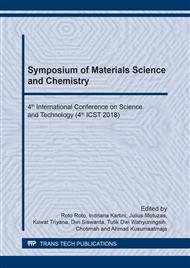[1]
K. Yisehak, Y. Kibreab, T. Taye, M.R.A. Lourenço, G.P.J. Janssens, Response to dietary tannin challenges in view of the browser/grazer dichotomy in an ethiopian setting: Bonga sheep versus kaffa goats, Trop. Anim. Health Prod. 48 (2016) 125-131.
DOI: 10.1007/s11250-015-0931-3
Google Scholar
[2]
Z.J. Miller, F.D. Menalled, U.M. Sainju, A.W. Lenssen, P.G. Hatfield, Integrating sheep grazing into cereal-based crop rotations: spring wheat yields and weed communities, Agron. J. 107 (2015) 104-112.
DOI: 10.2134/agronj14.0086
Google Scholar
[3]
Beriajaya, Tetriana, Pengaruh perasan dan ekstrak buah mengkudu (Morinda citrifolia l.) terhadap cacing haemonchus contortus secara in vitro, Prosiding Seminar Hasil-hasil Penelitian Ilmu Hayat, PAU Ilmu Hayat Institut Pertanian Bogor, (1999).
DOI: 10.14334/pros.semnas.tpv-2019-p.462-473
Google Scholar
[4]
N.D.R. Lastuti, Mufasirin, I.S. Hamid, Detection of Haemonchus sp. protein on sheep and goat using dot blot test with policlonal antibody of excretion and secretion protein of Haemonchus contortus, Media Kedokteran Hewan 22 (2006) 162-167.
Google Scholar
[5]
T. Eguale, G. Tilahun, A. Debella, A. Feleke, E. Makonnen, In vitro and in vivo anthelmintic activity of crude extracts of Coriandrum sativum against Haemonchus contortus, J. Ethnopharmacol. 110 (2007) 428 - 433.
DOI: 10.1016/j.jep.2006.10.003
Google Scholar
[6]
G.C. Coles, F. Jackson, W.E. Pomroy, R.K. Prichard, G. von Samson-Himmelstjerna, A. Silvestre, M.A. Taylor, J. Vercruysse, The detection of anthelmintic resistance in nematodes of veterinary importance, Vet. Parasitol. 136 (2006) 167-185.
DOI: 10.1016/j.vetpar.2005.11.019
Google Scholar
[7]
M. Nawaz, S.M. Sajid, M. Zubair, J. Hussain, Z. Abbasi, A. Mohi-Ud-Din, M. Waqas, In vitro and in vivo anthelmintic activity of leaves of Azadirachta indica, Dalbergia sisso and Morus alba against Haemonchus contortus, Glob. Vet. 13 (2014) 996-1001.
Google Scholar
[8]
C. Odhong, R.G. Wahome, M. Vaarst, S. Nalubwama, M. Kiggundu, N. Halberg, S. Githigia, In Vitro anthelmintic effects of crude aqueous extracts of Tephrosia vogelii, Tephrosia villosa, and Carica papaya leaves and seeds. Afr. J. Biotechnol. 13 (2014) 4667-4672.
DOI: 10.5897/ajb2014.14048
Google Scholar
[9]
W. Setyono, Kontrol parasit menggunakan hijauan sebagai agen anthelmintik pada kambing bligon betina, Thesis, Fakultas Peternakan Universitas Gadjah Mada, (2014).
Google Scholar
[10]
J. Daryatmo, Potensi nutrisi berbagai bahan pakan hijauan yang mengandung tanin dan efektivitasnya sebagai anti parasit dalam mendukung kinerja ternak kambing bligon, Dissertation, Fakultas Peternakan Universitas Gadjah Mada, (2010).
DOI: 10.21776/ub.jnt.2021.005.01.3
Google Scholar
[11]
AOAC, Official Methods of Analysis of AOAC International, 18th Edition. Assoc. of Anal. Chem,Washington, (2005).
Google Scholar
[12]
S.A. Abdulrazak, T. Fujihara, Animal Nutrition, A laboratory Manual, Kashiwangi Printing Company Matsue-shi, Japan, (1999).
Google Scholar
[13]
L.E. Ferreira, P.M.N. Castro, A.C.S. Chagas, S.C. França, R.O. Beleboni, In vitro anthelmintic activity of aqueous leaf extract of Annona muricata L. (Annonaceae) against Haemonchus contortus from sheep, Exp. Parasitol. 134 (2013) 327-332.
DOI: 10.1016/j.exppara.2013.03.032
Google Scholar
[14]
L. Istiqomah, S.N. Hayati, E. Damayanti, H. Julendra, A.A. Sakti, T. Untari, Performance and meat quality of broilers infected with Escherichia coli and administered with bio additive, probiotic, and antibiotic, Media Peternakan 36 (2013) 14-20.
DOI: 10.5398/medpet.2013.36.1.14
Google Scholar
[15]
Z.A. Zakaria, T. Balan, V. Suppaiah, S. Ahmad, F. Jamaludin, Mechanism(s) of action involved in the gastroprotective activity of Muntingia calabura. J. Ethnopharmacol. 151 (2013) 1184-1193.
DOI: 10.1016/j.jep.2013.12.045
Google Scholar
[16]
H.D. Naumann, J.P. Muir, B.D. Lambert, L.O. Tedeschi, M.M. Kothmann, Condensed tannins in the ruminant environment: a perspective on biological activity, J. Agr. Sci. 1 (2013) 8-20.
Google Scholar
[17]
N. Tharayil, , V. Suseela, D.J. Triebwasser, C.M. Preston, P.D. Gerard, J.S. Dukes, Changes in the structural composition and reactivity of Acer rubrum leaf litter tannins exposed to warming and altered precipitation: climatic stress-induced tannins are more reactive, New Phytol. 119 (2011) 132–145.
DOI: 10.1111/j.1469-8137.2011.03667.x
Google Scholar
[18]
E.M. Kuntorini, S. Fitriana, M.D. Astuti, Struktur Anatomi dan Uji Aktifitas Antioksidan Ekstrak Metanol Daun Kersen (Muntingia calabura), Prosiding Semirata FMIPA Universitas Lampung, (2013) 291-296.
DOI: 10.31001/biomedika.v11i2.422
Google Scholar


